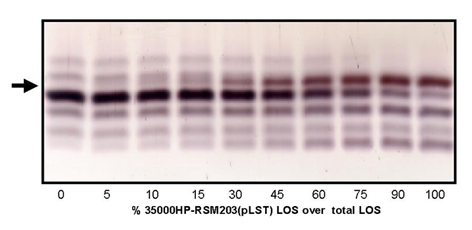
Supporting information for Goon et al. (2003) Proc. Natl. Acad. Sci. USA, 10.1073/pnas.0437851100

Fig. 5.
Silver stained SDS/PAGE gel of mixtures of LOS with increasing amounts of the sialylated glycoform. LOS from Haemophilus ducreyi strains 35000HP-RSM202, (a neuA mutant) which lacked the sialic acid-containing glycoform and strain 35000HP-RSM203(pLST), (a complemented lst mutant) which overexpressed the lst gene and therefore yielded a high level of sialic acid-containing glycoforms were analyzed by SDS/PAGE (at 10 ng·m l- 1). LOS of both strains (1) were mixed together at different ratios to generate defined LOS mixtures with different abundances of sialic acid containing glycoforms. The mixtures are expressed as a percentage of the 35000HP-RSM203(pLST) LOS component (high NeuAc content) of total LOS. On the far left is the LOS from the sialic acid deficient strain (0% lst mutant) and the far right is the overexpressing strain (100% lst mutant) with mixtures of the two in the middle. An arrow shows the position of the gel band containing the sialylated glycoform. Increasing the proportion of the complemented lst mutant (higher percentage on the x axis) resulted in stronger gel bands corresponding to the sialylated LOS (see arrow) and decreasing intensity for the gel band right below (nonsialylated lactosamine acceptor LOS). These siver stained SDS/PAGE gels were scanned with a densitometer and then used for quantification studies of sialylated LOS, providing an independent measure of the LOS glycoform population for comparison to the mass spectrometric methods.